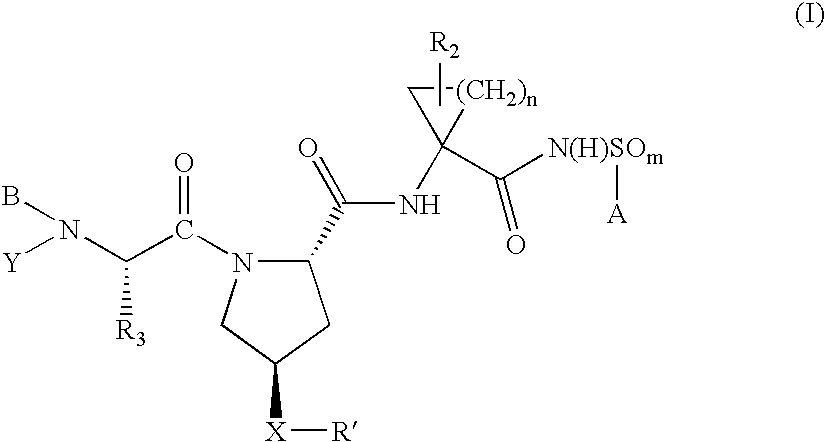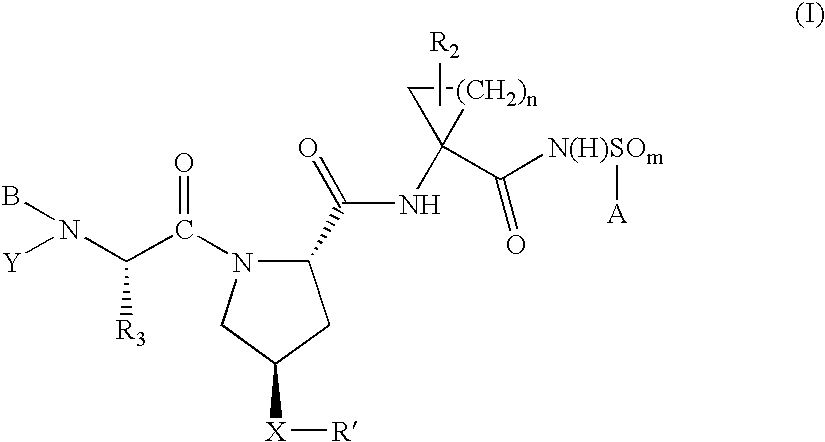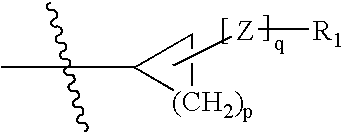Hepatitis C virus inhibitors
a technology of hepatitis c virus and inhibitors, which is applied in the field of antiviral compounds, can solve the problems that a large percentage of patients do not have a sustained reduction in viral load, and achieve the effect of inhibiting the function of ns3 proteas
- Summary
- Abstract
- Description
- Claims
- Application Information
AI Technical Summary
Benefits of technology
Problems solved by technology
Method used
Image
Examples
examples
[0254]The specific examples that follow illustrate the syntheses of the compounds of the instant invention, and are not to be construed as limiting the invention in sphere or scope. The methods may be adapted to variations in order to produce compounds embraced by this invention but not specifically disclosed. Further, variations of the methods to produce the same compounds in somewhat different manner will also be evident to one skilled in the art.
[0255]Solution percentages express a weight to volume relationship, and solution ratios express a volume to volume relationship, unless stated otherwise. Nuclear magnetic resonance (NMR) spectra were recorded either on a Bruker 300, 400 or 500 MHz spectrometer; the chemical shifts (δ) are reported in parts per million. Flash chromatography was carried out on silica gel (SiO2) according to Still's flash chromatography technique (W. C. Still et al., J. Org. Chem., (1978), 43, 2923).
[0256]All Liquid Chromatography (LC) data were recorded on ...
preparation of example 3
1-methylcyclopropylsulfonamide.
[0395]A solution of N-tert-Butyl-(1-methyl)cyclopropylsulfonamide (1.91 g, 10 mmol) was dissolved in TFA (30 mL), and the reaction mixture stirred at rt for 16 h. The solvent was removed in vacuo to give a yellow oil which was crystallized from EtOAc / hexane (1:4, 40 mL) to yield Example 3,1-methylcyclopropylsulfonamide, as a white solid (1.25 g, 96%): 1H NMR (CDCl3) δ 0.84 (m, 2H), 1.41 (m, 2H), 1.58 (s, 3H), 4.65 (bs, 2H). Anal. Calcd. For C4H9NO2S: C, 35.54; H, 6.71; N, 10.36. Found: C, 35.67; H, 6.80; N, 10.40.
[0396]
Preparation of N-tert-Butyl-(1-allyl)cyclopropylsulfonamide.
[0397]This compound, N-tert-Butyl-(1-allyl)cyclopropylsulfonamide, was obtained in 97% yield according to the procedure described in the synthesis of N-tert-Butyl-(1-methyl)cyclopropylsul-fonamide except 1.25 equivalents of allyl bromide were used as electrophile. The compound was taken directly into the next reaction without purification: 1H NMR (CDCl3) δ 0.83 (m, 2H), 1.34 (s,...
preparation of example 4
1-allylcyclopro-pylsulfonamide.
[0399]Example 4,1-allylcyclopropylsulfonamide, was obtained in 40% yield from N-tert-butyl-(1-allyl)cyclopropylsulfonamide according to the procedure described in the synthesis of 1-Methylcyclopropylsulfonamide. The compound was purified by column chromotography over SiO2 using 2% MeOH in CH2Cl2 as the eluent: 1H NMR (CDCl3) δ 0.88 (m, 2H), 1.37 (m, 2H), 2.66 (d, J=7.0 Hz, 2H), 4.80 (s, 2H), 5.16 (m, 2H), 5.82 (m, 1H); 13C NMR (CDCl3) δ 11.2, 35.6, 40.7, 119.0, 133.6.
[0400]
Preparation of N-tert-Butyl-[1-(1-hydroxy)cyclohexyl]-cyclopropylsulfonamide.
[0401]This compound was obtained in 84% yield using to the procedure described for the synthesis of N-tert-Butyl-(1-methyl)cyclopropylsul-fonamide except 1.30 equivalents of cyclohexanone were used, followed by recrystallization from the minimum amount of 20% EtOAc in hexane: 1H NMR (CDCl3) δ 1.05 (m, 4H), 1.26 (m, 2H), 1.37 (s, 9H), 1.57–1.59 (m, 6H), 1.97 (m, 2H), 2.87 (bs, 1H), 4.55 (bs, 1H).
[0402]
PUM
| Property | Measurement | Unit |
|---|---|---|
| temperature | aaaaa | aaaaa |
| temperature | aaaaa | aaaaa |
| temperature | aaaaa | aaaaa |
Abstract
Description
Claims
Application Information
 Login to View More
Login to View More - R&D
- Intellectual Property
- Life Sciences
- Materials
- Tech Scout
- Unparalleled Data Quality
- Higher Quality Content
- 60% Fewer Hallucinations
Browse by: Latest US Patents, China's latest patents, Technical Efficacy Thesaurus, Application Domain, Technology Topic, Popular Technical Reports.
© 2025 PatSnap. All rights reserved.Legal|Privacy policy|Modern Slavery Act Transparency Statement|Sitemap|About US| Contact US: help@patsnap.com



